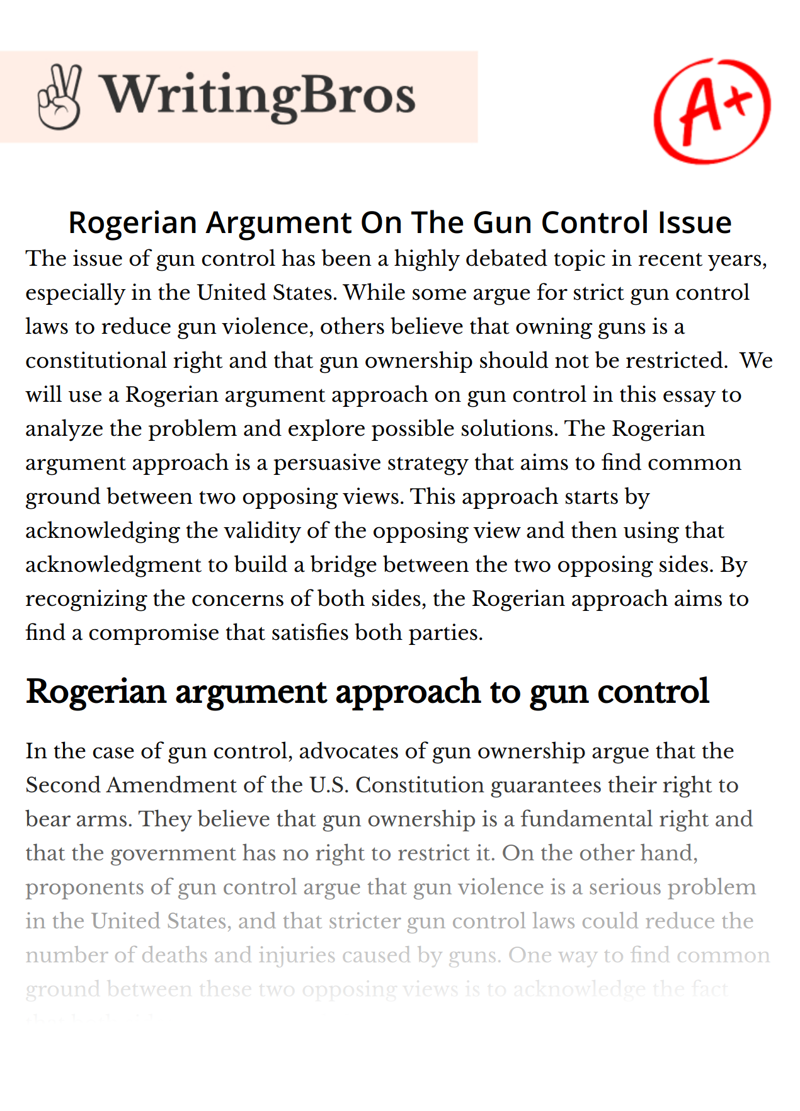Rogerian Argument On The Gun Control Issue

The issue of gun control has been a highly debated topic in recent years, especially in the United States. While some argue for strict gun control laws to reduce gun violence, others believe that owning guns is a constitutional right and that gun ownership should not be restricted. We will use a Rogerian argument approach on gun control in this essay to analyze the problem and explore possible solutions.
The Rogerian argument approach is a persuasive strategy that aims to find common ground between two opposing views. This approach starts by acknowledging the validity of the opposing view and then using that acknowledgment to build a bridge between the two opposing sides. By recognizing the concerns of both sides, the Rogerian approach aims to find a compromise that satisfies both parties.
Rogerian argument approach to gun control
In the case of gun control, advocates of gun ownership argue that the Second Amendment of the U.S. Constitution guarantees their right to bear arms. They believe that gun ownership is a fundamental right and that the government has no right to restrict it. On the other hand, proponents of gun control argue that gun violence is a serious problem in the United States, and that stricter gun control laws could reduce the number of deaths and injuries caused by guns.
One way to find common ground between these two opposing views is to acknowledge the fact that both sides are concerned about public safety. Proponents of gun control want to reduce the number of gun-related deaths and injuries, while advocates of gun ownership want to protect themselves and their families from harm. By recognizing this common concern, we can begin to explore possible solutions that address both sides of the issue.
One possible solution to the problem of gun violence is to implement stricter background checks for gun buyers. This solution acknowledges the concern of gun control advocates while respecting the rights of gun owners. By requiring more thorough background checks, we can ensure that guns are not sold to individuals who have a history of violent behavior or mental illness. This could potentially reduce the number of guns in the hands of people who are likely to use them for harm.
Another possible solution is to increase funding for mental health care. This solution acknowledges the fact that many incidents of gun violence are committed by individuals with mental illness. By providing better access to mental health care, we can potentially identify and treat individuals with mental illness before they become a danger to themselves or others. This could help reduce the number of incidents of gun violence in the United States.
It is important to note that while these solutions may be effective, they are not without their drawbacks. Stricter background checks could make it more difficult for law-abiding citizens to purchase guns for self-defense, and increased funding for mental health care could be expensive. However, by acknowledging these concerns and exploring possible solutions that address both sides of the issue, we can potentially find a compromise that satisfies both advocates of gun ownership and proponents of gun control.
In conclusion, the issue of gun control is a complex and highly debated topic, but by using a Rogerian argument approach, we can potentially find a compromise that satisfies both sides. By acknowledging the concerns of both advocates of gun ownership and proponents of gun control, we can explore possible solutions that address both sides of the issue. While these solutions may not be perfect, they have the potential to reduce gun violence and protect the public's safety.
References
- DeFilippis, J. (2019). The Case for Gun Control. In J. DeFilippis & A. DeLuca (Eds.), The Routledge Handbook of Critical Criminology (pp. 150-161). Routledge.
- Jones, R. (2018). The Right to Bear Arms: A Constitutional Right or a Threat to Public Safety?. Journal of Law and Social Policy, 28(1), 105-124.
- Kalesan, B., Mobily, M. E., Keiser, O., Fagan, J. A., & Galea, S. (2016). Firearm legislation and firearm mortality in the USA: a cross-sectional, state-level study. The Lancet, 387(10030), 1847-1855.
- Lott, J. R. (2013). More guns, less crime: Understanding crime and gun control laws. University of Chicago Press.
- Malloy, D. C. (2016). Mental Health and Gun Control: How Fear Hinders Progress. William & Mary Bill of Rights Journal, 25(4), 1197-1224.
Cite this Essay
To export a reference to this article please select a referencing style below

